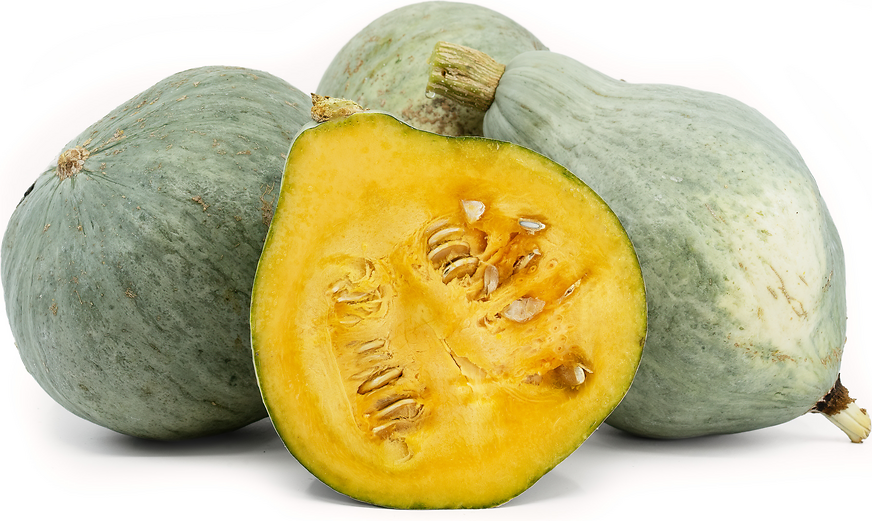


Blue Hubbard Squash
Estimated Inventory, lb : 0
Description/Taste
Blue hubbard squash is large in size, averaging thirty centimeters in diameter and ranging 5-40 pounds in weight. Oval and plump in shape, Blue hubbard squash is somewhat bulbous in the middle and slightly tapered at the neck leading to a corky, rough, light brown stem. The semi-thin rind is very tough, bumpy with some smooth patches, and pale blue-green-gray in color. The flesh is orange to golden yellow, fine-grained, and dense with a large central cavity filled with stringy pulp and many large, flat, cream-colored seeds. When cooked, Blue hubbard squash is tender and starchy with a rich and semi-sweet, nutty flavor similar to that of cooked pumpkin.
Seasons/Availability
Blue hubbard squash is available in the fall through early winter.
Current Facts
Blue hubbard squash, botanically classified as Cucurbita maxima, is a winter heirloom variety and a member of the Cucurbitaceae family along with pumpkins and gourds. The hubbard squash was the first squash introduced to the United States that was thought to have the desired flavor and texture that the upper class was searching for. Before its introduction, the only squashes available in North America were woody stemmed pumpkin types which were thought to be for the lower classes because of the poor flavor and consistency. The Blue hubbard became the most successful of all the hubbard squashes developed in the late 1800’s and early 1900’s and is still sought after by squash enthusiasts today for its large size and smooth, nutty flavor.
Nutritional Value
Blue hubbard squash contains fiber, iron, potassium, vitamin A, beta-carotene, vitamin C, and niacin.
Applications
Blue hubbard squash is best suited for cooked applications such as roasting, baking, boiling, or steaming. The large squash should be cut in half, seeds discarded, and the skin should be removed either before or after cooking as it is inedible. When cooked, Blue hubbard squash can be added to pies, casseroles, risotto, and pasta preparations. It can also be pureed and added to soups, stews, sauces, curries, and desserts and can be used in recipes as a substitute for pumpkin or butternut squash. Blue hubbard squash pairs well with white beans, cinnamon, nutmeg, curry, brown sugar, maple syrup, ginger, clove, chipotle, toasted walnuts, chard, kale, leek, fennel, shallot, sage, apple, pear, sausage, ground beef, pork, and cheeses such as mascarpone, parmesan, and goat. It will keep up to six months when stored in a cool and dry place.
Ethnic/Cultural Info
The hubbard squash is believed to be named after Elizabeth Hubbard, the washwoman of James Howard Gregory who was the seedsman to first commercially introduce the squash in America. Gregory presented the hubbard squash at a time when only fibrous and poor flavored winter squash types were available in America. First introducing the green variety and then later introducing the Blue hubbard, the hubbard varieties would become one of the most sought-after squash in New England and the United States for its creamy, sweet, and nutty flavor. Gregory experienced such success from the hubbard that he went on to become the largest seed grower in America by 1900 and published a book titled Squashes How to Grow Them. He was also the first to introduce seed packets with pictures and instructions, a type that would go on to become a standard in the industry.
Geography/History
The hubbard squash first made its way to North America via sea captains returning home with seeds and crops from explorations in South America in the nineteenth century. Legend has it, Captain Knott Martin shared the seeds of what would come to be known as the hubbard squash with his sister, Sarah Martin who would be the first to grow the squash and develop it on American soil in her home garden. She was a shy woman and was too timid to approach a known seedsman and entrepreneur in the community, James Howard Gregory, so she gave the seeds to her friend and Gregory’s washwoman, Elizabeth Hubbard. Elizabeth gave the seeds to Gregory, and in 1854 he released the first hubbard squash known as the green hubbard. Later Gregory would go on to develop an improved green hubbard, the marblehead, and eventually the famous Blue hubbard. In 1870, the Blue hubbard was developed from a chance cross between the marblehead and middleton. In 1909 the Blue hubbard was released commercially and would historically become the most well-known hubbard squash. Today Blue hubbard squash is available at specialty grocers and farmers markets in the United States.
Recipe Ideas
Recipes that include Blue Hubbard Squash. One
| Amy Glaze's Pommes D'amour |
|
Truffled Blue Hubbard Squash Soup |
| Northwest Edible Life |
|
Curried Sugar Hubbard Squash Soup |

















